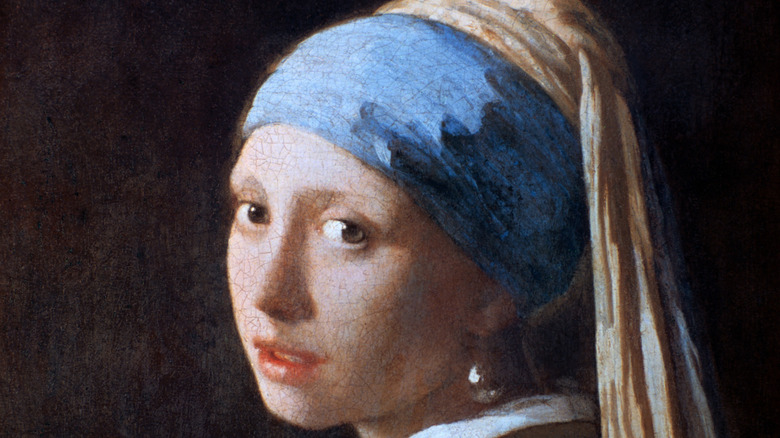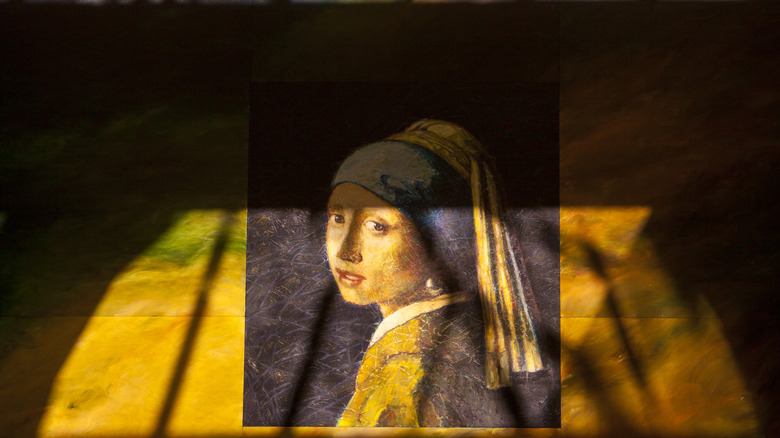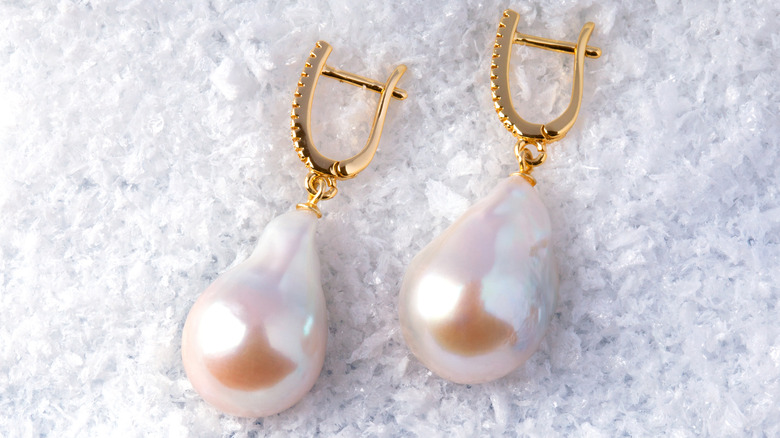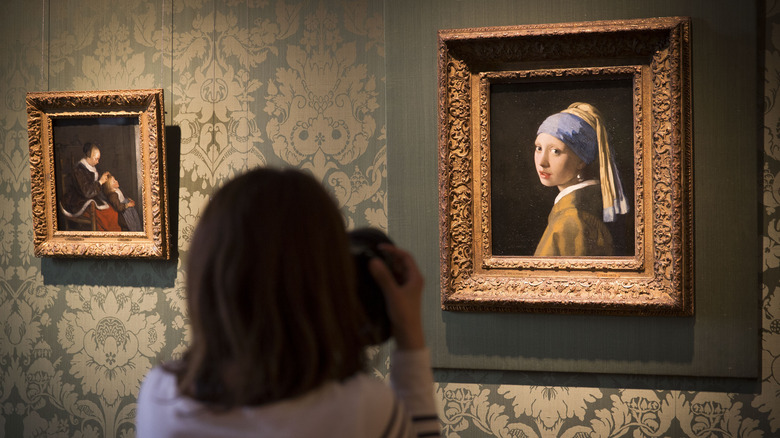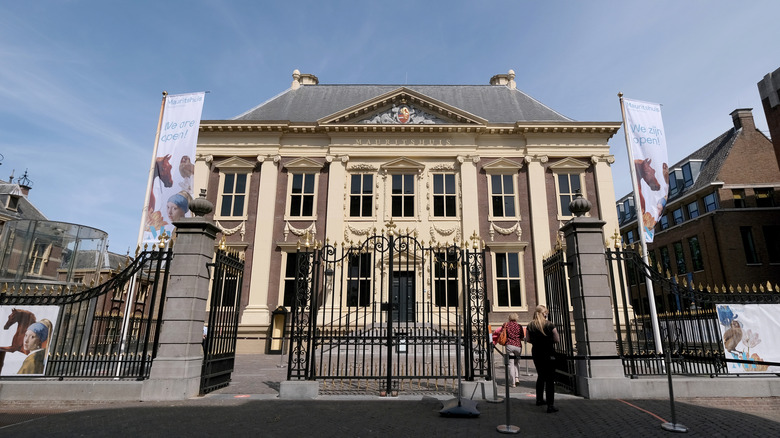The Truth About The Girl With A Pearl Earring Painting
Johannes Vermeer's 17th-century oil painting "Girl with a Pearl Earring," is one of the greatest mysteries of the art world. According to The Frick, the painting is an example of a "tronie," or a Dutch portrait that features an expressive face and striking details; in this case, the subject's blue turban and large pearl earring are the objects of interest. In addition to its accepted title, the painting has been called "Girl in a Turban," "Head of Girl in a Turban," "The Young Girl with Turban," and, simply, "Head of a Young Girl."
"Girl with the Pearl Earring" is also frequently referred to as the "Mona Lisa of the North," per Mental Floss. The Vermeer painting is believed to have been completed in the Netherlands in 1665, 150 years after the believed completion of Leonardo da Vinci's 16th-century Italian portrait. But the enigmatic qualities of the women featured in each portrait have intrigued disciples of history and pop culture alike.
"Sometimes the questions are more intriguing because they can't be answered," said Melissa Buron, assistant curator of the 2013 "Girl with a Pearl Earring" exhibit at San Francisco's de Young museum, in an interview for The Wall Street Journal. "Who was she? What was she thinking? What was her relationship with Vermeer? The mystery is part of its popularity."
The "Girl with a Pearl Earring" could have been Vermeer's daughter
Who is the "Girl with a Pearl Earring"? This question is central to most discussions and even fictionalized explorations of the painting. According to Mental Floss, one of the most popular theories is that the girl was Maria, the eldest daughter among Johannes Vermeer's 10 children. Some historians have also noted the similarities between the model and those used in other Vermeer paintings, including "Art of Painting" and "Young Woman with a Pearl Necklace."
Journalists Jean-Louis Vaudoyer and Lawrence Weschler, as well as Baroque and Renaissance art specialist Benjamin Binstock, have supported the theory that Maria was the "Girl with a Pearl Earring." Binstock put his case forth in a 2013 article for Slate, in which he pointed out that the recurring figures in Vermeer's works include members of his immediate family, including his wife and daughters, and even the family maid. "Girl with a Pearl Earring" is dated 1665, and Maria was born in 1654, meaning she would have been just eleven years old at the time, which seems unlikely. But Binstock suggests the painting was actually painted in 1670 when Maria was 16 years old.
Speculation about the identity of Vermeer's model has extended beyond the history and art realms and into the realm of fiction. It has been the subject of several fictionalizations, including Tracy Chevalier's 1999 novel "Girl With a Pearl Earring: A Servant's Life, a Master's Obsession, a Matter of Honour" and its 2003 film adaptation, both of which featured the Vermeers' maid as the subject.
The girl's earrings may not have been pearls at all
In addition to the girl, an element of intrigue in "Girl with a Pearl Earring" is — you guessed it — the pearl earring. Some scholars draw connections between the painting and 17th-century Bishop St. Francis De Sales, who wrote, "Both now and in the past it has been customary for women to hang pearls from their ears ... The first part of the body that a man wants, and which a woman must loyally protect, is the ear; no word or sound should enter it other than the sweet sound of chaste words, which are the oriental pearls of the gospel" (via Mental Floss).
Various experts have suggested that the pearl Johannes Vermeer painted was faux. Theoretical Astronomy professor Vincent Icke wrote in a 2014 New Scientist article that the way the light reflects off the pearl in the painting would not match the reflection on a real pearl. Art curators Quentin Buvelot and Ariane van Suchtelen also noted the unusual size of Vermeer's pearl. "Large pearls were rare and ended up in the hands of the richest people on the planet," they explained (via Mental Floss). "In the seventeenth century, cheaper glass pearls, usually from Venice, were also quite common ... Maybe the girl is wearing such a handcrafted 'pearl'."
The Frick notes that pearls appear in eight of Vermeer's paintings. Due to the unprecedented size of the pearl in "Girl with a Pearl Earring," the museum theorizes it was either a varnished glass drop or a figment of Vermeer's imagination.
Restorations have revealed lost details of "Girl with a Pearl Earring"
In 1994, restoration work on "Girl with a Pearl Earring" led to the discovery that one of the highlights on the surface of the pearl was, in fact, a flake of paint, per the Frick. The project also revealed an original highlight on the girl's lip, which had been painted over during a previous conservation project. Those working on the 1994 treatment also found that the background, which now appears completely black, was actually composed of a translucent green paint over a darker paint that grew discolored with age. According to Mental Floss, the translucent overpaint — designed to make the dark background glisten — was a mixture of indigo and weld glaze.
Johannes Vermeer painted the girl's turban with an ultramarine paint made from crushed lapis lazuli. Because it was made from a semi-precious stone, the paint was pricey, but Vermeer was known to use it even in times of financial trouble. His use of light and shadow in lieu of distinct lines has also baffled historians, though many believe he used a camera obscura, or a darkened room with an image projected through a hole. The 2013 documentary "Tim's Vermeer" successfully tested the hypothesis that the artist also used an arrangement of mirrors in his painting process.
The "Girl with a Pearl Earring" now has a permanent home
"Girl with a Pearl Earring" is dated 1665, but the painting did not sell until two centuries later, in 1881. According to Mental Floss, the painting was bought at an auction by art collector and Dutch Army officer Arnoldus Andries des Tombe for two guilders with a 30-cent premium. When des Tombe died in 1902, he left the painting to the Mauritshuis, an art museum in The Hague in the Netherlands, where it remains today.
The Mauritshuis has previously loaned the painting to museums in other countries — including Italy, Japan, and the United States — for temporary exhibitions. In 2013, the painting traveled across the Atlantic to the United States, where large crowds gathered to see it on display in cities throughout the country. But in 2014, the museum announced that the painting would no longer travel and that Johannes Vermeer's mysterious masterpiece would remain on the walls of the Mauritshuis indefinitely.
